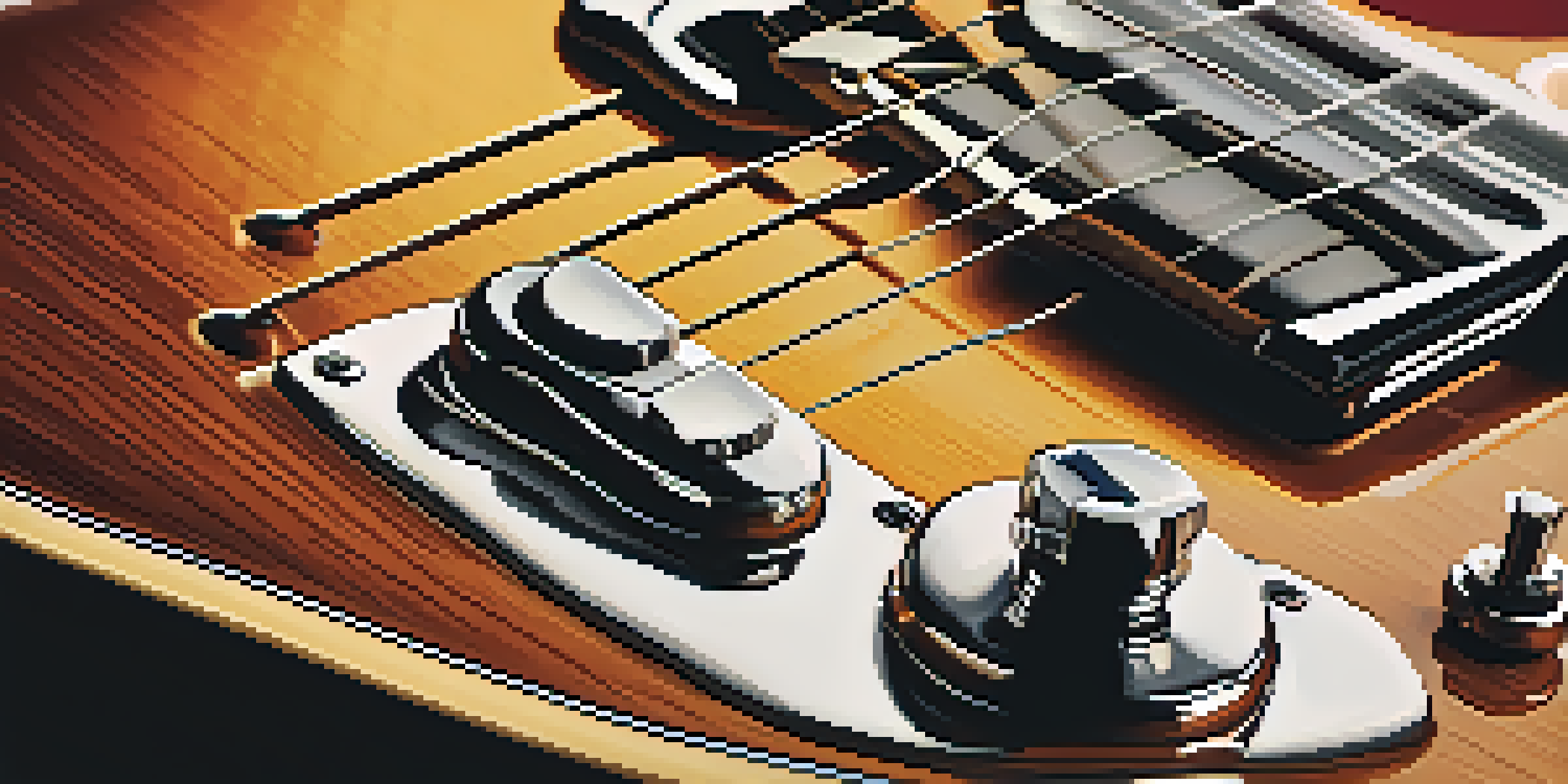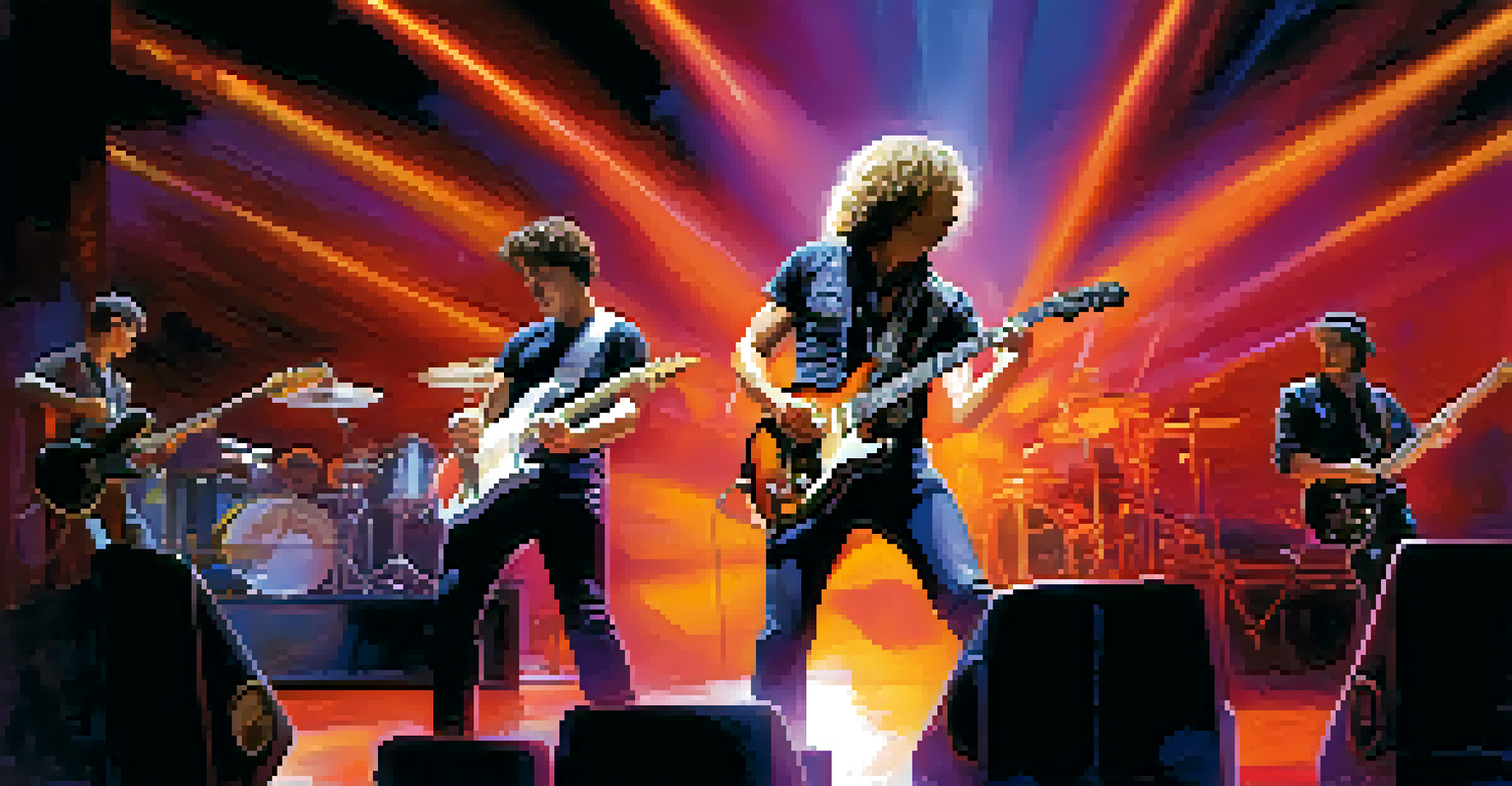Electric Guitar's Rise: How Technology Changed Music History

The Birth of the Electric Guitar: A New Sound Emerges
The electric guitar made its debut in the early 1930s, setting the stage for a musical revolution. Unlike traditional acoustic guitars, the electric guitar utilized electromagnetic pickups to amplify sound, which allowed musicians to explore new tonal possibilities. This innovation quickly caught the attention of jazz and blues artists, who embraced the device as a means to stand out in crowded band settings.
The electric guitar is the most versatile instrument in the world.
The first commercially successful electric guitar, the Rickenbacker 'Frying Pan', was a game changer. Its unique sound and design sparked the imagination of musicians everywhere, leading to a surge in demand for electric models. As more manufacturers entered the market, the possibilities for innovation began to expand, paving the way for a variety of styles and genres.
This new instrument didn't just change how musicians played; it also transformed the very landscape of popular music. With the electric guitar now at the forefront, artists could express themselves in ways that acoustic instruments simply couldn't accommodate, laying the groundwork for future musical styles.
The 1950s: A Decade of Innovation and Influence
The 1950s marked a significant turning point for the electric guitar, as iconic models began to emerge. Instruments like the Fender Stratocaster and Gibson Les Paul became symbols of rock 'n' roll, attracting legendary musicians who would shape the future of music. These guitars offered players a range of sounds that matched the energy and rebellious spirit of the era.

During this decade, artists like Chuck Berry, Buddy Holly, and Elvis Presley harnessed the power of the electric guitar to create unforgettable hits. Their innovative use of the instrument not only captivated audiences but also inspired countless aspiring musicians. This period laid the groundwork for a new genre that combined rhythm, blues, and rock, forever changing the music landscape.
Electric Guitar Revolutionizes Music
The electric guitar's introduction in the 1930s transformed musical expression, allowing artists to explore new sonic possibilities and genres.
As technology advanced, so did the electric guitar itself. Enhanced pickups, improved amplification, and the introduction of effects pedals allowed musicians to experiment with their sound, leading to the birth of various sub-genres. The electric guitar became more than just an instrument; it was a vehicle for creative expression.
The 1960s: The Electric Guitar Takes Center Stage
The 1960s saw the electric guitar stepping into the limelight, with bands like The Beatles and The Rolling Stones leading the way. Their innovative approaches to songwriting and performance showcased the electric guitar's versatility, captivating audiences worldwide. Suddenly, the guitar became a symbol of youth culture and rebellion, resonating with a generation eager for change.
The guitar is a miniature orchestra in itself.
This era also witnessed the rise of guitar heroes like Jimi Hendrix, who pushed the boundaries of sound and technique. Hendrix's groundbreaking use of feedback, distortion, and improvisation inspired countless musicians to explore new sonic territories. His electrifying performances demonstrated the electric guitar's potential to convey deep emotions and connect with audiences on a personal level.
As rock music flourished, so did the electric guitar's role in various musical movements, including psychedelic rock and folk rock. The instrument became a canvas for experimentation, leading to a diversity of styles that still influence artists today. The electric guitar was no longer just an instrument; it was an integral part of the cultural zeitgeist.
The 1970s: A Fusion of Styles and Genres
The 1970s marked a period of experimentation and fusion in music, with the electric guitar at the forefront. Genres like hard rock, punk, and funk emerged, each bringing unique approaches to guitar playing. Artists began to blend different styles, creating a rich tapestry of sound that showcased the instrument's versatility.
This decade also saw the birth of the heavy metal genre, with bands like Black Sabbath and Led Zeppelin pushing the electric guitar's limits. Their powerful riffs and solos captivated fans and inspired a new generation of musicians. The electric guitar became synonymous with energy, rebellion, and raw power, leaving an indelible mark on music history.
Guitar Heroes Redefine Performance
In the 1960s and 1980s, iconic musicians like Jimi Hendrix and Eddie Van Halen showcased the electric guitar's technical potential, influencing countless aspiring players.
Moreover, advancements in technology continued to shape the electric guitar's evolution. The introduction of new materials, like lighter woods and synthetic components, allowed for more unique designs and improved playability. This period of innovation not only enhanced the instrument but also broadened its appeal, making it accessible to a wider audience.
The 1980s: The Rise of Guitar Virtuosos
The 1980s ushered in an era dominated by guitar virtuosos, with players like Eddie Van Halen and Steve Vai showcasing their incredible skills. These musicians pushed the boundaries of technique and creativity, introducing new playing styles like tapping and sweep picking. Their innovative approaches set a high bar for aspiring guitarists and inspired a wave of technical proficiency.
The electric guitar became a symbol of excess during this decade, with flashy solos and extravagant performances taking center stage in rock music. The rise of hair metal bands further amplified this trend, as guitarists embraced the instrument's ability to dominate the stage. It was a time when the electric guitar was not just an instrument but a key component of the rock star persona.
Additionally, the introduction of digital effects and synthesizers transformed the electric guitar's sound. Musicians could experiment with various tones and textures, creating entirely new sonic landscapes. This technological advancement allowed for even greater creativity, leading to the birth of sub-genres like shred and progressive metal.
The 1990s and 2000s: A Shift in Musical Trends
The 1990s brought a shift in musical trends, with genres like grunge and alternative rock gaining prominence. Bands such as Nirvana and Pearl Jam often favored raw, stripped-down guitar tones over the flashy solos of previous decades. This change showcased the electric guitar's adaptability, proving it could thrive in any musical context.
During this time, the electric guitar also found a new home in genres like hip-hop and electronic music. Collaborations between guitarists and DJs led to innovative sounds and crossover hits, expanding the instrument's reach beyond traditional rock settings. The electric guitar began to blend seamlessly with technology, allowing for new creative possibilities.
Electric Guitar's Cultural Impact
Today, the electric guitar remains a symbol of creativity and self-expression, continuing to adapt and thrive across diverse musical genres.
As the internet became a powerful tool for music distribution, aspiring guitarists gained access to a wealth of resources and inspiration. Online guitar tutorials and social media platforms allowed musicians to connect and share their work like never before. This democratization of music further solidified the electric guitar's role in shaping contemporary music.
The Present Day: The Electric Guitar's Enduring Legacy
Today, the electric guitar remains a vital force in music, with countless genres still embracing its unique sound. While technology continues to evolve, the essence of the electric guitar endures, inspiring new generations of musicians. From indie rock to metal, the instrument's versatility allows it to adapt to the ever-changing musical landscape.
Modern advancements, such as modeling amps and digital effects, have opened up new possibilities for guitarists. These innovations enable musicians to experiment with a wide range of tones and styles without the need for extensive gear. The electric guitar's ability to evolve with technology ensures its relevance in contemporary music.

Moreover, the electric guitar has transcended its role as merely an instrument, becoming a cultural icon. It symbolizes creativity, freedom, and self-expression, resonating with musicians and fans alike. As long as there is music, the electric guitar will continue to play a pivotal role in shaping its future.